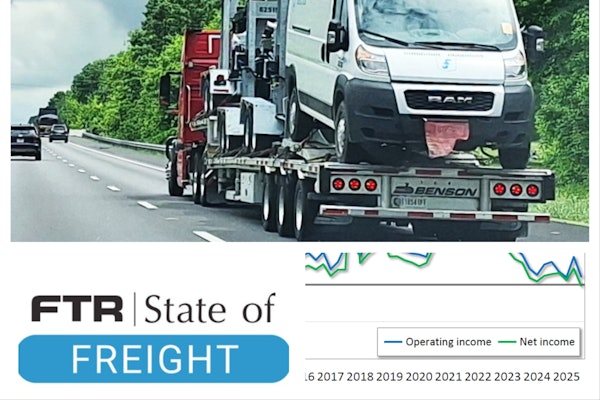It is not uncommon for trailers that are well-maintained to provide dependable service for 25 years or more. That requires a preventive maintenance program suited to your type of trucking, and regular checks of the running gear, lighting, cargo securement fixtures, doors and other components for physical damage and signs of small problems that could grow into big, expensive ones on the road.
The trucking industry’s long-term objective is a 10-year maintenance-free trailer, according to Meritor Heavy Vehicle Systems. Transcraft, Wabash and many other trailer makers are able to offer longer warranties because component manufacturers are developing products that extend maintenance intervals. One such product is a unitized wheel end that eliminates seal leaks and the damage oil does to brake linings – a major trailer maintenance problem.
Keeping your trailer’s brakes in peak operating condition, so that each one does part of the braking, is the best way to minimize stopping distances and avoid penalties during roadside inspections. S-cam brakes and automatic slack adjusters should be lubricated according to the manufacturers’ recommended service interval.
Listen for air leaks in the brake system, and check to see that air lines are not damaged. Check for cracked drums, missing or broken shoes, and shoes soaked with grease, brake fluid or oil. Also, keep an eye open for damaged brake chambers and replace them as needed. Glad hands and rubber seals should be checked for signs of damage and wear.

Brake shoes should be relined or replaced with remanufactured shoes when they wear down to 1/4-inch at their thinnest point. Linings should be replaced on both sides of an axle at the same time to avoid brake pull. Shoe return springs should also be replaced when you reline.
Brake drums should be inspected periodically for damage and excessive wear. Drums can be resurfaced to remove shallow grooves and moderate heat checking, but look for the cause of the damage and correct the root problem before you remount. Drums with deep, wide cracks should be replaced.
Suspension trouble signs
Whether you pull a van or flatbed, the most important item to inspect regularly is the suspension, according to Great Dane Trailers. The suspension is most prone to failure if it’s not properly maintained, says the trailer manufacturer. Suspension problems are the second most common category of defects cited by roadside inspectors, after brakes.
Signs of misaligned, shifted, cracked or missing springs; loose or missing shackles and bolts; spring hangers unsecured at the frame; and cracked or loose U-bolts can all put your rig out of service in an inspection. Spring packs with 25 percent or more of the leaves broken should be replaced to avoid the possibility of an out-of-service citation during a roadside inspection.
A good rule of thumb is to perform regular trailer maintenance checks every six months or 15,000 miles, although some items, such as wheels, should be checked every 2,000 to 3,000 miles, advises Great Dane. The company recommends the following schedule:
- Every 25,000 to 30,000 miles, check for brake lining wear; inspect the camshafts, camshaft spider bushings and camshaft support bracket bushing for signs of wear; and lubricate brake actuating components.
- Every 100,000 miles, once a year, or at brake reline, replace the wheel bearing lube oil; check brake air chambers and slack adjusters; and inspect brake rollers, roller shafts, anchor pins and bushings, and replace if necessary.
- Proper lubrication is essential to prolong the life of any trailer. Keep the landing gear and doors lubed to ensure smooth operation. Metal suspension components require lubrication and retorquing at regular intervals to prolong their life and help your suspension operate at peak performance.
- Hit all zerk fittings with your grease gun. Bronze bushings should be lubricated, but rubber bushings should not, since lubricants can damage them. Keep lubricants away from rubber blocks and other rubber suspension components, too.
- Sliding tandem axles are subjected to extreme stress, and they should be checked regularly for damage. Periodic lubrication of the pin release mechanism reduces the effort needed to pull the handle and helps prevent lock pins from binding. The slider’s components should be lubed according to the manufacturer’s guidelines.
- Check the slider box for deformation and fractures. Indexing holes can become worn or elongated, so watch them. Washing out the frame to avoid carrying around a load of road salt or dirt inside it is also a good idea.
Most air suspension failures can be traced to a lack of preventive maintenance or improper application. The correct ride height should be maintained within 1/4-inch of the OEM’s established height. Leveling valves should be cleaned, inspected and replaced if malfunctioning.
On trailers with air ride suspensions, Firestone Industrial Products Co., which manufactures Airide air springs, recommends periodic checks to detect:
- Signs of irregular wear or heat cracking of the air springs
- Rubbing contact between air lines and the air springs
- Insufficient clearance around the air springs while at maximum diameter
- Buildup of dirt, debris and other foreign materials on the piston of the air springs
To clean air springs, use soap and water or methyl, ethyl or isopropyl alcohol. Do not use organic solvents or abrasives, says Firestone. Direct pressurized steam cleaning is not recommended.
Broken, leaking or worn shock absorbers should be replaced since shocks serve to limit the rebound of air springs and keep them from overextending. The tightness of all fasteners should be checked periodically and retorqued to the manufacturer’s specifications.
Kingpin is a critical link
Check the kingpin and bolster or skid plate for signs of damage or looseness, and check all welds for cracks. A loose kingpin causes excessive trailer chucking and rapid fifth-wheel-lock wear. Striking the kingpin with a hammer should produce a solid, metallic ring, which indicates secure welds. A dull sound indicates that the kingpin mounting should be checked more closely.
The kingpin should be checked for straightness using a kingpin gauge or a carpenter’s square. A bent kingpin can interfere with fifth wheel locking and accelerate lock wear. Kingpin wear should be checked with a kingpin gauge. If the kingpin slips into the gauge slot, indicating 1/8-inch or more of wear, it should be replaced.
Also check the kingpin’s length with the gauge. Using a greaseless lube plate on the fifth wheel might require a longer kingpin to compensate for the thickness of the material and avoid locking problems. A kingpin that is too long can also cause problems with locking.
The bolster plate should be checked for flatness in all directions using a 48-inch straight-edge. Warping and high or low areas on the plate promote uneven loading of the fifth wheel and can damage the top plate and locks. The bolster should be securely attached to the trailer frame.
Treat tires as an investment
Tires represent a significant investment and should be treated as such in your maintenance program. Closely track the condition of each tire and do everything you can to extend its useful service life. That includes maintaining each casing for retreadability and retreading the tire as many times as possible.
Keep tires inflated to proper pressure and check the condition of the tread and sidewalls. When you check tires, keep the following tips in mind:
- No fabric should be showing.
- At least 1/8-inch of tread is required.
- Check for signs of tread separation.
- Dual tires should not touch each other or the trailer.
- Valve stems should have no cuts or cracks.
Routinely check wheel nuts for tightness, especially shortly after a tire has been changed. Rust around nuts is a sign they may be loose. Check wheels for bent, cracked or missing parts.
Proper inflation is the most important part of tire maintenance. Excessive heat caused by underinflation severely shortens a tire’s service life. A tire under load heats up 5 degrees for every two pounds of underinflation due to the increased flexing. That produces steel cord fatigue, the main cause of tire blowouts. A tire that is underinflated by 20 pounds, which isn’t unusual, runs 50 degrees hotter than it should.
Inflation pressures should always be checked when the tires are cold, since operating the vehicle causes an increase in pressure of 10 to 15 psi as temperatures rise. Air should never be bled from hot tires to relieve normal pressure buildup. Bleed air only from cold tires to bring the pressure down to the proper level.
Longer-lasting lighting
Lighting is number one in frequency of repair on a vehicle and number three in cost of repair. The most common lighting problems are corrosion at the connectors and lamp sockets, bulb durability and problems with wiring.
Vehicle washing, road salt or simply operating in a wet climate can cause corrosion. It attacks wiring, connections and electrical contacts. To fight corrosion, lubricate all bulb sockets, pigtails and electrical wiring connections, including electrical contacts, circuit switches and junction boxes, with a non-conductive, non-sodium-based grease to seal out moisture and other elements.
Voltage surges shorten bulb life. Voltage should be checked regularly because only one volt beyond the designed voltage reduces the expected life of a bulb filament by more than 50 percent. Replace any burned-out bulbs and cracked or broken reflectors. Lamps grounded to the trailer chassis through the lamp housing require a clean metal-to-metal contact for a proper ground. Check for corrosion that can result in an improper ground.
Electrical wires should not be frayed or damaged. They should be securely fastened to the trailer chassis, not hanging down. When replacing wiring, always use a gauge of wire that is equal to or heavier than the original. Stranded copper wire is preferable to aluminum, which can develop oxides at crimp connections, reducing its ability to carry current.
Lighting manufacturers recommend that you test all lamps before you discard them. Nearly half of all lamps returned under warranty are still in good operating condition, manufacturers report. Color clues aid in determining why bulbs fail and can be valuable in troubleshooting. Open the lens to check the color and condition of the bulb before you discard a failed lamp. Here’s what the colors indicate:
- Silver-gray bulb indicates excessive voltage.
- Yellowish bulb indicates the housing leaked.
- Dark metallic finish indicates old age.
- Black sooty bulb indicates an internal short.
- Bulb with broken or stretched filaments was subjected to vibration.
Conspicuity markings – retroreflective tape or reflex reflectors – are now required on the sides and rear of all heavy-duty trailers. Retroreflective tape, also called sheeting, reflects incoming light back to the source. Unlike reflectors, the adhesive-backed material does not break. New materials are fade-resistant and weather well.
The conspicuity markings must be replaced as part of a repair when they are damaged. Make a point of keeping the lights and reflective markings clean. That increases your visibility on the road and decreases the likelihood of you and your rig becoming traffic statistics.







